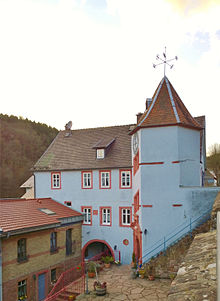Hammer lock
The Hammerschlösschen is a small castle on Ulfenbach on the eastern outskirts of Wald-Michelbach ( Neckarstrasse 29 ) in the Bergstrasse district in Hesse . Combined with the former company, it is also referred to as Eisenhammer Wald-Michelbach .
history
The castle was built around 1600 for Johann Caton as a mansion for the industrial iron hammer .
From 1565 to the middle of the 19th century, Hans Caton , the father of the locksmith builder , existed here on the basis of a document from Elector Friedrich III. built and operated iron hammer, called Wald-Michelbacher hammer or Huy'scher hammer . His father already had larger property through the hammer mill and the copper mine near Reichenbach (Lautertal) , Johann Caton 1606 with the copper mine near Gorxheim , 1611 as owner of the Weschnitz iron ore mines and from 1613 at the latest as master of the hut and hammer in Wald-Michelbach, as owner of the ironworks of Stromberg in Hunsrück and from 1619 as Lord of Audenschmiede in Weilmünster rounded off with great success and a small empire in the early modern iron industry built. Johann Caton died childless in 1623.
After the end of the Thirty Years War , the Ensinger family immigrated from the County of Rappoltstein in Alsace to the Odenwald and determined the fortunes of the Odenwald iron industry for almost 50 years. In 1657 Conrad Ensinger became the owner of the Electoral Palatinate , completely ruined and dilapidated by the war, Eisenhammer in Wald-Michelbach. It can be assumed that he also bought the small castle building. In 1678 his widow Katharina Ensinger took over the property. As a successor, first daughter Eva Maria Ensinger , later her cousin Johann Ezechiel Haffner , owned the Wald-Michelbacher Hammer in 1685. Haffner is mentioned for the last time in 1699.
In 1727 the iron hammer was sold to the Mannheim merchant Johann Heinrich Weyl , who, however, had to leave it to his creditor Baud for use after twelve years due to over-indebtedness . After the death of Johann Heinrich Weyl in 1747, a 23-year-long legal dispute between his descendants and those of his creditor Baud followed, which could not be ended with a settlement until 1770. Weyl's daughters finally sold the Eisenhammer in 1776 to Adam Schmitt and his son, who in turn sold it to Johann Wolfgang Renner just three years later . He had the business renewed for the high sum of 12,000 guilders and ran it very profitably. According to information, the new house was built near Hammer in 1779, but probably only expanded. His son continued the business, then a Baron von Riedheim and from 1853 a Christian Huy , from which the Eisenhammer also got its nickname.
The iron hammer is converted into a grinding mill from 1865 .
Building description
The narrow courtyard of the hammer lock is reached via an arched gate entrance with lions and balusters through the rectangular two-storey main building, which is detached due to the hillside location. On the courtyard side, a hexagonal stair tower with a renaissance portal and double sloping twin windows following the course of the stairs is attached. It has a round-arched entrance, surrounded by a rectangular frame with fluted half-columns on both sides on high plinths with lion heads. The surfaces are filled with ornamental fittings . A rectangular aedicule is set on the blasted triangular gable . Is located on the southern front of the castle between the windows on the gate entrance, a crest motif with the initials IWR and the year 1779. The crest panel is the former owner J ohann W olfgang R assign Enner. A Neidkopf is attached to the main building next to the stair tower .
Today the castle is maintained privately and can only be viewed from the outside.
See also
- Mining and metallurgy in the Odenwald: Wald-Michelbacher Hammer
- Wald-Michelbach Castle in the town center, overbuilt by a church
Individual evidence
- ↑ Historical significance and mining history of the Weschnitz-Rohrbach mining district , pp. 4–6. In: Jens-Uwe Eder, Jochen Babist: Avoiding damage to mining relics by using alternative wood-backing technology using the example of the Weschnitz-Rohrbach mining district (municipalities of Fürth and Reichelsheim, Odenwald, Germany) , online publications by the Geo-Naturpark Bergstrasse-Odenwald e. V. 2009. accessed: April 1, 2015. ( digitized version )
- ↑ a b Mößinger: Mines and iron hammers in the Odenwald, p. 51
- ↑ a b Hammerschlösschen ( memento from December 25, 2014 in the Internet Archive ) on the touristik-odenwald.de page
Web links
- Entry on Waldmichelbach (Hammerschlösschen) in the private database "Alle Burgen".
literature
- Peter and Marion Sattler: Burgen und Schlösser im Odenwald , Verlag Edition Diesbach, Weinheim 2004, ISBN 3-936468-24-9 , p. 120
- Friedrich Mößinger: Mines and iron hammers in the Odenwald (= writings for local history and home care in the Starkenburger area. Issue 21/22, ZDB -ID 971701-8 ). Verlag der "Südhessische Post", Heppenheim 1957. pp. 51–58
Coordinates: 49 ° 33 '58.2 " N , 8 ° 50' 38.1" E










